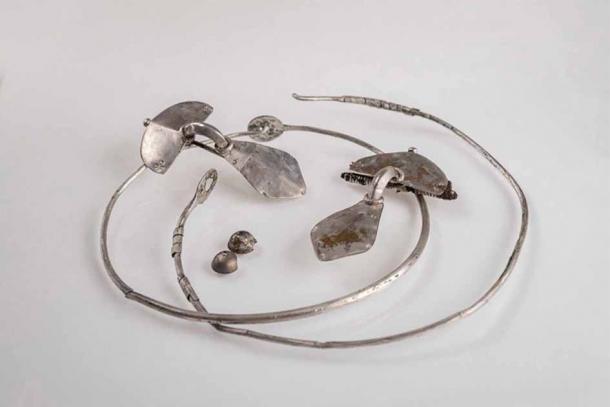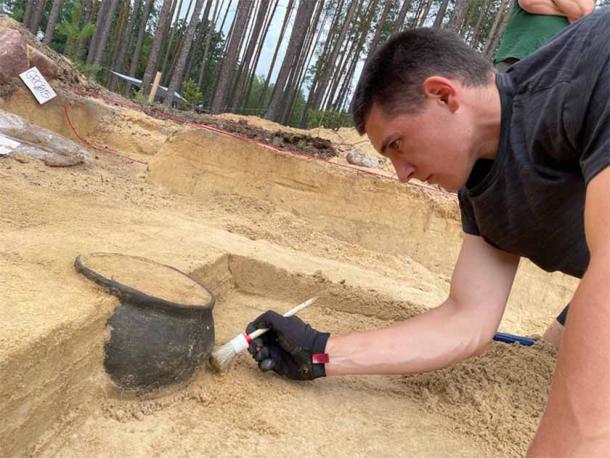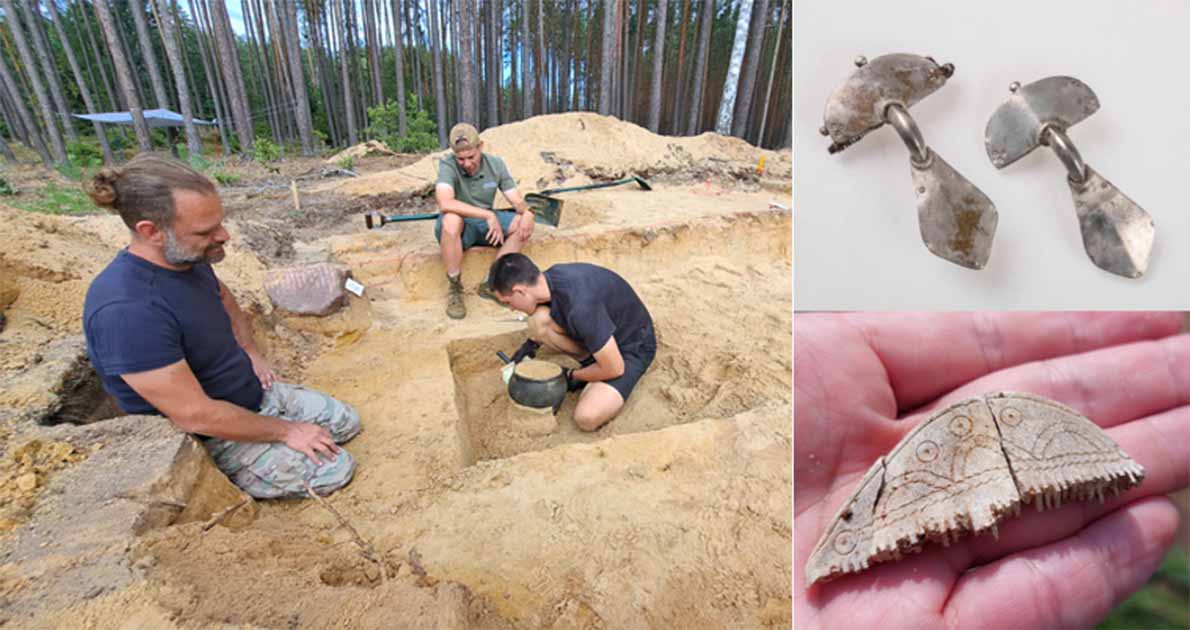Polish Digs Unveil Goth Graves Gleaming with Treasures
Wdecki Park Krajobrazowy, nestled near the village of Stara Rzeka in northern Poland, represents a unique environment wherein the pristine Wda River winds through lush forests, serene lakes and diverse wildlife. It was against this fairytale backdrop that archaeologists recently excavated 50 Goth graves dating back to the 4th century AD. The burials contained hoards of “priceless artifacts” that were imported from Scandinavia in the north to the Black Sea in the south.
A report on The First News explained that the precious artifacts were found in two types of burials: pit graves and urn burials. The items discovered within the Goth graves included “decorated pottery, brooches, amber beads, two silver necklaces, two silver fibulae and elements of a necklace made from small silver beads, as well as jewelry with snake motifs.”

The unearthing of silver artifacts which helped archaeologists locate the Goth graves. (Wdecki Park Krajobrazowy / Facebook)

The treasure trove unearthed within the Goth graves included two silver necklaces, two silver fibulae and elements of a necklace made from small silver beads. (Olaf Popkiewicz)
International Treasures Unearthed in Goth Graves
The discoverer of the site was archaeologist Olaf Popkiewicz, who runs the YouTube channel History Seekers (Poszukiwacze Historii). Popkiewicz first identified the site last year while walking on the banks of the Wda River, beside the village of Osie. After finding several silver artifacts he contacted local heritage officials who later discovered the “two silver necklaces, two silver fibulae, and pieces of a silver bead necklace,” which are all described as being in “excellent condition.”
- Sacrificial Treasure Trove of Bronze Age Artifacts Found in Peat Bog
- Over 800 Ancient Monuments Found in Polish Forest with LiDAR!
Popkiewicz recently posted on Facebook that over the last three weeks the team has analyzed over “250 square kilometers, and that they have excavated a cemetery with over 50 graves!” The burials have been associated with the Wielbark culture, which thrived along the Vistula River in Poland during the Roman Iron Age (1st to 4th centuries AD).
This culture is regarded as an archaeological manifestation of the Goths, who were a diverse group of Germanic tribes with origins in modern-day Scandinavia. This can help explain why the Goth graves contained silver objects including pieces from far-flung locations including Scandinavia and the Black Sea.

The excavations of Goth graves have also revealed a perfectly intact 2,000-year-old urn. (Wdecki Park Krajobrazowy)
Beliefs in the Afterlife Revealed by Goth Graves
The Goths migrated to and settled in the area that is now Poland during the Roman period. With a heavily fortified landscape, the Goths in Poland became very efficient agriculturalists, developing distinctive burial customs including the use of grave artifacts in burial rituals. The team of archaeologists who excavated the remains of a Goth settlement noted its “well-preserved spatial arrangement.”
An article in Archaeonews features one of the excellently preserved 2,000-year-old urns discovered by archaeologists within the Goth graves. This artifact serves as a microscope looking into the Wielbark culture's burial customs. Containing intricate jewelry, weaponry and personal items, the elaborate Goth graves speak of the culture's artistic skill, as well as the distinctive inhumation practices which highlight the social status and religious beliefs of the interred.

The landscape in which the Goth graves were discovered. (Wdecki Park Krajobrazowy)
Deriving Goth Cosmo-Data from Grave Goods
Each one of these burials contributes to the archaeological understanding of the Goths' migration and settlement patterns across Europe. The artifacts uncovered within the Goth graves ranged from weapons to exquisite fibulae to pottery. These speak both of the culture's interactions and cultural exchanges with neighboring groups, as well as their influence and dependence on wider trade networks.
- Polish Dog Unearths Rare Booty of Revealing Bracteate Medieval Coins
- Development of Advanced Pottery by “Barbarians” Found in Poland
The Goths left a profound spiritual imprint on ancient Poland through the Wielbark culture’s religious practices which are recorded in their distinctive burials, symbolic artifacts and sacred spaces.
These remnants offer a glimpse into Goth cosmology, providing details and nuanced data about their beliefs pertaining to life and death, including their reverence for nature. The Goths' presence in Poland, reflected in historical records and archaeological discoveries such as this one, demonstrate their central role in the spiritual mosaic of early Europe.
Top image: Artifacts excavated from the Goth graves in Poland have provided evidence of their funerary practices and cosmology. Source: Wdecki Park Krajobrazowy / Olaf Popkiewicz
By Ashley Cowie

















